
 |

Assembly
With all of the electrical and water hose
connections made, it was time to fill the system with water. The
nice thing about the bleeder container is that I didn't need to remove
any hoses to fill the system. Water is poured in the container until
it is almost full and the pump is turned on. As the pump starts to
circulate the water through the system, more water is added. When
it will take no more water, a few taps on the clear hoses helps to dislodge
air bubbles stuck to the sides of the hoses. The pump has enough
pressure to move the air through the system and expel it through the container.
Add the four screws to fasten down the rubber gasketed lid and it's a done
deal.
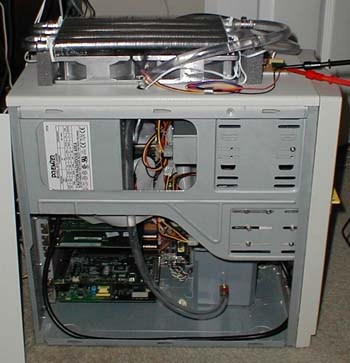 |
In testing this system on the bench, I
found that for water to circulate without the aid of a pump, it was necessary
that the radiator be the highest point in the system. It was also
seemed to be important that there were no sharp bends in the hoses.
With this in mind, the hoses make rather lazy turns to attach to the radiator.
This doesn't make for the cleanest looking set up, but will suffice until
I come up with a better looking solution. Having the water circulate
by convection (if the pump should die) is more important than looks.
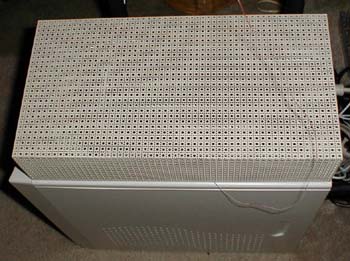 |
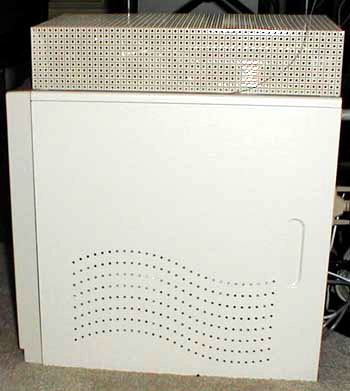 |
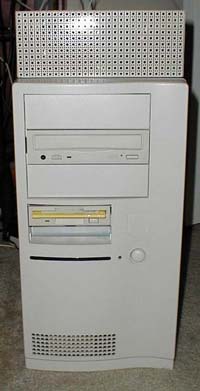 |
Tests
To see how the new cooler performed, I
first tested the K6-233 "Big Sink"
to give me a base line of some pretty good (though noisy) performance.
The test consisted of looping Quake2 timedemos in X-Windows. I then
tested the water cooler. I finished off the tests by unplugging the
pump at the end of the water cooler test and watching to see how high the
thermometer rose with only convection circulating the water.
As you can see by the chart, the temperature of the processor and water block rise while the temperature of the radiator stays at a low, fairly constant level. The probe for the radiator temperature is placed so that the water makes 3 passes through the radiator before the temperature is read. Because of the slow circulation that "convection only" produces, the water is pretty cool by the time it reaches the sensor. Unfortunately, even with the extra tubing I used to keep from having too sharp of bends and to keep the hoses below the height of the radiator, I am not getting as good of water circulation in the case as I got on the work bench. However, even with the flow not as good as I would have liked it, the performance is still good enough to keep the processor from going into meltdown should the pump stop working.
While testing on the bench, I had the idea
to add a second water block on the output side of the radiator. This block
was cooled by a pair of 40 mm peltiers and the peltiers were cooled by
a fan assisted heat sink. The idea being that if I could chill
the water on the "downhill" side of the water circuit, the difference in
temperatures between the hot side and cold side would speed up the pumpless
circulation. I was somewhat successful with this and it did speed
up the circulation, but adding a pair of peltiers adds more heat to get
rid of. It's a vicious cycle and one that caused more problems to
solve than just using a pump. It is an idea that I'm still thinking
about, though.
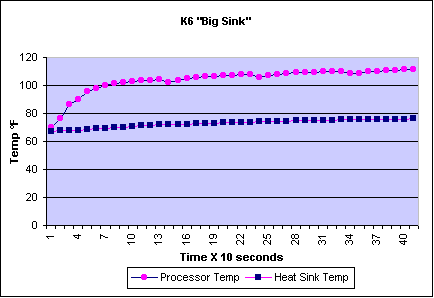 |
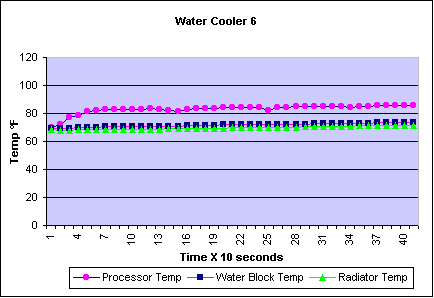 |
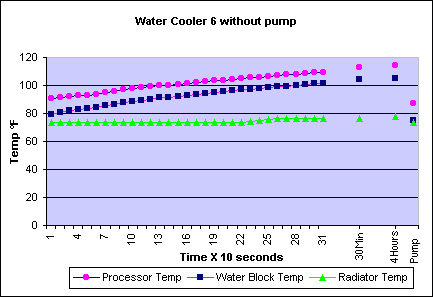 |
Closing Thoughts
I've had this water cooler up for about
3 weeks now and am pretty pleased with this prototype. The typical
difference in temperature between the room temp and the temp on the back
side of the processor is about 3.1°F with the server just performing
its usual light duties. This includes WWW, FTP, mail, and file server,
as well as my connection to the internet for the rest of the computers
on the home LAN.
As for the "quiet factor," this system has worked out well. The noisiest pieces in the system are the hard drives and power supply fan. There's not much I can do for the hard drives except to insulate the case or rubber mount each drive in hope of keeping noise transmission to a minimum. The power supply will get a new fan one of these days.
The next step is to start on a new full tower case for a more powerful processor. I am getting quite dependent on having two computers at my desk and the K6-233 just doesn't have quite enough speed for all that I want it to do.
|
|
|
|